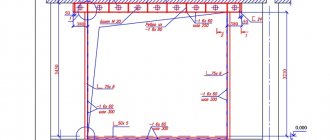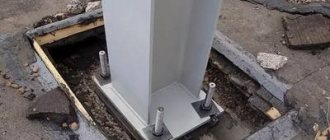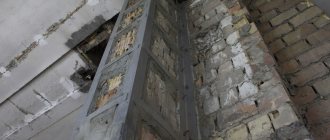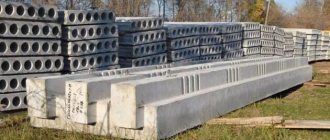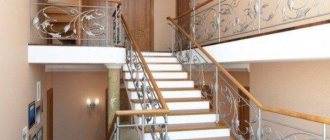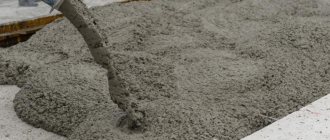Strengthening reinforced concrete structures is an effective way to extend the life of certain elements and the entire building in general. There are many methods for strengthening various structures, depending on their purpose, operating characteristics, type and condition, work tasks and other conditions. And it is very important, before starting work, to correctly determine the method of strengthening, and then calculate and carry out everything.
An increase in the load-bearing capacity of structures can be carried out without changing their stress state or structural scheme (metal or reinforced concrete frame, extension, reinforced concrete jacket) or with a change in the stress state of the structural scheme itself (metal beams supported on piles, prestressed struts, racks, consoles, struts , horizontal spregel/combined puffs).
As a rule, strengthening a reinforced concrete structure involves much lower costs compared to completely replacing elements with new ones. Often the impossibility or complexity of replacement is due to the need to implement expensive and large-scale construction processes (strengthen the foundation or rebuild the building, for example). It is also important that structures are strengthened without stopping production, operation of premises and buildings, or with short-term stops.
Reinforcement is most often used for reinforced concrete columns, foundations, floor slabs, and crossbars. But crane reinforced concrete beams are usually replaced with new ones instead of reinforcement. The same applies to reinforced concrete trusses that have fallen into disrepair - they are dismantled and replaced with new ones (often made of metal) or repaired.
The most difficult work is to strengthen beams, foundations, and crossbars. Fewer difficulties involve strengthening reinforced concrete columns and floor slabs. Regardless of which element is planned to be strengthened, any work is justified by the project.
Why is structural reinforcement required?
Any operations designed to strengthen reinforced concrete structures are carried out with the aim of improving load-bearing characteristics and extending service life. Various products are restored after prolonged wear or subject to the loss of certain properties under the influence of external negative and other factors.
Reasons for the need to strengthen reinforced concrete structures and elements:
- Increased load on an element due to strengthening or replacement of structures located above (superstructure of structures, reconstruction of premises).
- Modernization of technological equipment and changes in technological processes in the building that is being reconstructed.
- Acquired structural defects that have appeared as a result of improper operation of structures, spills or splashing of aggressive liquids.
- Operational wear (when load-bearing capacity is lost due to vibration/dynamic loads, the influence of an aggressive air environment and other factors).
- Accidental damage – when individual structural elements fail during the dismantling, installation or transportation of process equipment.
Strengthening columns with clips
Columns are building structures that, together with the main walls, reliably hold the upper floor slabs. They do not allow the ceiling to sag and, therefore, experience increased load.
Columns are not just decorations of buildings inside or outside, they are an important structural element of the building. The famous Atlas sculptures supporting the canopy of the entrance to the New Hermitage in St. Petersburg are perhaps the most striking example of highly artistic columns.
Reasons for the destruction of columns
But, unfortunately, nothing lasts forever under the sun. Since any column is made of building materials, this structure is subject to aging over time. Sometimes it happens that in a building erected just a few years ago, when calculating the columns, the developers made a mistake in calculating the load-bearing load, as a result of which the structures quickly collapse.
Also, the builders may well have failed to maintain the technology when constructing the columns, or, which happens not so rarely, in order to save money, the developer saved on the cost of especially strong concrete and replaced it with a cheaper brand. The result in these cases is always the same - you will have to strengthen the columns.
- In a word, as soon as you see that the plaster on the columns has become bulging or, worse, that cracks have appeared along it (especially in the upper part), you immediately need to not just start cosmetic repairs, but take more drastic measures.
Where does the strengthening of columns begin?
What exactly should be done (and whether it should be done) can only be decided by civil engineers. It is they who, after conducting a construction examination, will make a verdict on the need to strengthen the columns and choose the most optimal method of major repairs.
Our company has a design department, whose specialists will analyze the condition of the structure and carry out a design for strengthening the reinforced concrete column. This will not require large expenses, but it will become clear whether it is necessary to resort to serious measures (and strengthening the columns with clips is an extremely important task), or whether the cracks are just a false alarm.
To carry out a construction examination, samples are taken in the column for analysis:
In addition, engineers calculate all types of loads that the structure actually experiences. As a result, you will know exactly whether it is necessary, and if so, how urgently it is necessary to strengthen the reinforced concrete column.
How columns are reinforced with steel clips
To reinforce the columns with clips, our craftsmen will cut four steel corners of the calculated number to the size of the height of the column. Next, these corners are installed on a strong cement mortar at the four corners of the structure.
To ensure reliable reinforcement of the columns in the future, the corners are tightened with special clamps. As a result, they are pressed against the surface of the column until the cement mortar begins to squeeze out.
Reinforcement of columns with clips should be carried out only after the corners are stuck. Next, steel strips (planks) of the calculated length are cut. Before welding the metal strips to the corners of the strip, they are heated, thereby causing linear expansion of the material (the strips lengthen under the influence of temperature).
Only after this the steel strip is welded. Moreover, the strengthening of the columns will be carried out reliably if all four strips are welded at the same height, and then the next belt is made above it at the calculated height. So the column is covered with metal strapping at equal intervals up to the very top, and the last belt of strips is attached right under the ceiling.
After cooling, the metal strips are shortened, and the entire frame of the column reliably holds and strengthens the supporting structure, due to which the reinforced concrete column is strengthened.
Work to strengthen reinforced concrete structures
Strengthening concrete structures can be carried out using a variety of methods and involve carrying out certain activities.
Functions and measures to strengthen reinforced concrete structures:
- An increase in the cross-section of certain structural components is realized by concreting in layers with a reinforcing frame, using shotcrete, and injecting mortar into the formwork.
- Strengthening load-bearing parts through the installation of new elements is carried out thanks to the correct distribution of pressure, reducing the impact on the part due to the installation of additional elements.
- Increasing the technical characteristics of reinforced concrete products due to the installation of external reinforcement frames - various anchors, channels, reinforcement, concrete layers, prestressed parts, steel sheets, etc. are installed.
- Release and precise distribution of influence by transferring it to other parts of the structure - for this, new consoles are added, existing parts are modified, parts with a large mass are replaced with elements with less weight.
- Installation of special soles, concrete piles, stops underground - the method of drilling holes with diamond drills in the right places and then filling them with concrete mortar is usually used. This makes it possible to increase the resistance of underground elements.
Our services
carries out injection with a preliminary examination of the object. Travel of an expert outside the Moscow region is paid. After the conclusion of the contract, the amount paid for the examination must be returned to the customer.
List of injection works:
- repair of dry, wet or heavily flowing cracks, cold joints of concrete structures;
- strengthening brick or stone masonry with microcements;
- cut-off waterproofing device to create anti-capillary protection;
- sealing expansion joints and openings for laying communications;
- soil strengthening, creation of impervious curtains under the foundation.
General information
Any methods of strengthening reinforced concrete structures require responsible and important construction operations, the implementation of which requires certain design skills, knowledge to make calculations, etc. In order to strengthen and reconstruct elements, a variety of methods and actions can be used.
Operations related to the strengthening of reinforced concrete structures are among the processes of increased complexity compared to conventional installation work. After all, when restoring slabs or floors, foundations or trusses, the master does not have the opportunity to understand and see the original position of the structure, there are no exact technical specifications, etc. This is especially important to take into account when it comes to old buildings, the lack of information regarding the position of internal elements, fittings, actual pressure distribution, etc.
Due to the high level of risks, such operations are carried out strictly according to instructions, in compliance with safety precautions, and a large number of safety measures. Specific installation conditions are taken into account, with limited access to tools, limited space, and the inability to stop work.
To reduce the level of danger and increase the speed of work, everything is done according to a pre-drawn schedule, with a clear definition of methods and technology planning.
The work is supervised by special government services and qualified specialists. Projects require approval from various authorities and proper execution.
The main methods of strengthening reinforced concrete structures:
- Creation of unloading structures with consistent changes in the static work scheme.
- Extension of sections in the format of clips, concrete strips, shirts. The betonka is made on 1 side, the shirt on 3, the clip on 4.
The creation of unloading structures involves their inclusion in joint work with the structure being strengthened directly during installation; production does not have to be stopped, which in many cases is the most important factor.
The second method involves stopping the process, partially unloading structures for subsequent loading, as well as incorporating various types of extended elements into the work. The method is quite labor-intensive, involves wet concreting processes, requires additional time (when the concrete gains strength), but is universal.
Strengthening reinforced concrete structures by repairing the protective layer of concrete includes the following methods: replacement/restoration of the protective layer (partial/solid), sealing individual sinkholes and gouges. When a complete replacement is performed, the thickness of the protective layer is increased (the minimum value is 3 centimeters for working reinforcement and 2 centimeters for non-working fittings and clamps).
The protective layer is replaced in cases where the properties of the monolith are reduced, the reinforcement is covered with corrosion, and peeling of the protective layer is observed. Then the old layer is completely removed, the reinforcement is cleaned of rust, and a new protective layer of concrete is laid.
Reinforced concrete jackets are made in case of serious damage to the surface concrete layer to protect the structure from further deformation. To repair significant damage, use manual plaster with a trowel: lay it, then after an hour moisten it with water, carefully sprinkle it with dry cement, smooth it with a trowel, or metal/wooden trowels.
The depth of the gouged out zones should not decrease towards the edge of the recess, it should be at least 1 centimeter everywhere, and the transition of the gouge to the whole protective layer is made as a step at an angle of 90 degrees.
If the volume of work is significant, it is important to use shotcrete, when concrete is applied under strong pressure and creates a durable and dense protective layer. When the monolith is being prepared for concreting, single cracks more than 1 millimeter wide are cut into rectangles and caulked with concrete. Where the spalls are large and the reinforcement is visible, use a reinforcing mesh with squares of 2.5-10 centimeters and a wire cross-section of 0.5-6 millimeters, attaching them to the main reinforcement.
To increase adhesion between new/old concrete, add a layer of K-153 glue (epoxy-thiokol). The concrete is laid until the adhesive is no longer sticky.
Ways to eliminate cracks:
- Creation of protective films/coatings
– if the crack opening is no more than 0.2 millimeters. Coatings of this type are created by painting concrete with synthetic varnishes and polymer-cement paints.
- Sealing cracks
– they are filled with elastic waterproof materials, the method is suitable for cracks larger than 0.3 millimeters. The access of moisture to the crack and reinforcement is closed, mastic and syringes are used.
- Surface sealing
– create a sealing overlay that covers the defect and strengthens the section with a crack, suitable for cracks from 0.2 millimeters. The structure becomes monolithic; the method is implemented by injecting an epoxy compound or cement solution. The process of performing the work: creating holes, installing nipples for supplying glue, sealing the crack with a fiberglass sticker, injecting the lower and subsequent nipples.
- Strength seal
– the crack cavity is made monolithic using glue, suitable for cracks from 0.3 millimeters, protects against chemical and atmospheric corrosion.
The most common method of strengthening structures is to increase the cross-section through one-sided extension or the creation of all-round clips. Such methods of reinforcement make it possible to significantly increase the load-bearing capacity of damaged/intact elements.
If a one-sided increase in the cross-section of reinforced concrete structures is implemented, additional reinforcement is welded (by electric welding, double flank seams) to the old one using vertical and inclined clamps, short pieces, and bends.
If there is local damage in the form of single/concentrated cracks at a minimum length, the structure is strengthened as follows: local four-sided cages are made of reinforced concrete (reinforced with clamps, bent/longitudinal reinforcement), metal cages are made of prestressed vertical clamps.
When oblique/vertical cracks are observed, longitudinal distribution angles are installed under the clamps, which should cover the entire damaged part of the beam. All clamps are concreted or covered with shotcrete.
In cases where it is necessary to strengthen the columns, the cages are reinforced with longitudinal rods and clamps or spiral reinforcement. The cage can be concreted in formwork or covered with shotcrete. The wall thickness is at least 10 centimeters for conventional concreting and 5 centimeters for shotcrete. It is better to chip off the corners of a column that is being strengthened.
At the bottom/top of the column at a length corresponding to the largest dimension of the transverse diameter of the column, the pitch of the clamps is reduced by 2 times. If there are local defects, a reinforcing ring is made within the boundaries of the deformed zone with a bypass of 50 centimeters in both directions, but not less than the cross-sectional value.
Strengthening reinforced concrete structures by building up elements:
- On the reinforcement side, chop off the protective layer at the welding points, clean the longitudinal bars of the reinforcement to half the diameter.
- Rinse the surface of the concrete with a stream of water running under pressure; if this is not possible, make notches with a chisel, treat with a brush, blow with air to remove dust, and then rinse with water.
- Apply plastic concrete to a damp surface (a solution in a ratio of 1:2, in a layer 1-2 millimeters thick).
- Concreting with new concrete.
All exposed reinforcement bars are thoroughly cleaned with metal brushes, sandblasting or another method to remove rust, dirt, and scale. If the damage to the rods is serious, the damaged film is removed with a hammer or chisel, cleaned with a steel brush, and new reinforcement is welded. Before concreting, the rods are painted with a 1:2 cement mixture in a layer of 2 millimeters.
The formwork is installed in such a way that it can be gradually increased in accordance with the height of the reinforced columns and beams. When formwork is created, the necessary holes and gaps are provided in it, special trays for pouring concrete, and seals. Sprayed shotcrete or poured conventional concrete is then provided with optimal care.
Additional activities and technological features
The package of work may also include additional procedures: elimination of defects by injection or gluing and other measures to restore the solidity of structures and their parts.
Activities related to strengthening the load-bearing structures of buildings are considered work of increased complexity and are more responsible compared to the construction of facilities from scratch. This is due to the fact that during restoration it is very difficult to correctly calculate all processes, since the initial data may be inaccurate or insufficient.
In addition, in most cases, the work is associated with old buildings, where it is not possible to obtain complete information about the state of internal and hidden components, the actual distribution of loads and other equally important parameters.
This type of work is very dangerous and requires compliance with all safety regulations in order to avoid accidents and emergencies.
Indications for the use of work to strengthen floors
Measures to improve the characteristics of reinforced concrete floors are carried out in case of urgent need. For prevention or just like that, a set of measures cannot be carried out.
When is it important to reinforce floors?
- The product has worn out and strength indicators have decreased due to corrosion, deterioration of the properties of materials, due to external chemical influences.
- Changing the layout of a building - when the design of load-bearing elements changes, as a result of which the pressure on the elements is redistributed.
- An increase in the number of floors in a building, which increases pressure on the foundation, basement, floors, and other elements, which may result in deformations.
- Ground movements that cause foundation deformations increase the load on supports and walls supporting structural elements.
- Deformation/wear of individual building elements due to military, man-made, natural impacts, accidents, etc.
- Reconstruction of a building or change in functions, due to which new methods of destruction appear (high temperatures, vibration and other influences).
- Elimination of miscalculations that were made during the preparation of the project or implementation of installation operations.
These are the main problems, the solution to which may involve increasing the overlap. The decision to strengthen a reinforced concrete structure is made after a thorough examination, clarification of the characteristics of the components and the maximum strength capability and the effective loads on each element.
After research, in accordance with their results, a project is created, the elements to be strengthened are prescribed in it, all technical data and costs of the measures are indicated. Usually, calculations for strengthening floors are entrusted to professionals from design companies, since without experience and knowledge it is very difficult to do everything correctly.
How to strengthen
To strengthen individual elements or the entire structure, a variety of methods and techniques are used. Some of them are used more often, others less frequently, but all of them can improve the performance of reinforced concrete elements and eliminate certain problems.
How to strengthen a reinforced concrete structure:
- Plaster for restoration of elements, insulation of reinforcement and protection against corrosion, elimination of damage to the surface.
- Injection into damaged areas for restoration.
- Applying concrete mortar under pressure using special equipment - shotcrete method. Thanks to the high feed speed and pressure, the concrete layer becomes dense and durable.
- Strengthening floors and other elements by creating special cages above the structure itself: the back frame, concreting by pouring mortar into the formwork, applying the mixture in layers with vibration.
- Strengthening the base slab using special anchors, clips, and belts.
- Strengthening reinforced concrete elements with carbon fiber, Kevlar, and other similar substances.
- Installation of unloading components - this can be a console, a spacer.
Strengthening reinforced concrete structures allows you to significantly extend the life of buildings and elements, eliminate unsafe areas, eliminate the consequences of accidents, qualitatively prepare the structure for changes in layout or reconstruction, etc.
Basic methods of strengthening walls, diaphragms, columns
Increasing the cross-section by installing reinforced concrete frames and jackets
In order to strengthen reinforced concrete columns and walls, additional longitudinal and transverse reinforcement is installed near the concrete surface with anchoring to both the concrete wall and the floors. Next, an additional layer of concrete is laid by pouring into formwork or shotcrete. In both cases, it is necessary to select the composition of concrete or a special repair mixture according to the characteristics: strength, mobility, aggregate fraction, etc.
Advantages of the method
- Versatility
- High degree of strength gain
- Ability to use common materials
- Low requirements for the qualifications of performers.
Disadvantages of the method
- Increasing the dimensions of the finished structure
- Long period of work and concrete strengthening
- High labor and material intensity
- High price.
Installation of steel reinforcement clips
When implementing this technique, columns and walls along the edges are framed with corners made of hot-rolled steel, tightened horizontally with steel strips. All reinforcement elements for columns and walls are welded. If it is necessary to transfer the load from the floors close to the overlying and underlying floors, horizontal corners are installed, gaps are selected with wedges or filled with non-shrinking cement, vertical elements can be prestressed. To create a triaxial compression effect in the concrete of the column, resulting in increased compressive strength, the horizontal laths must be prestressed by heating. In some cases, it may be necessary to mechanically secure the metal to the concrete by installing expansion or chemical anchors.
Advantages of the method:
- Ability to use common materials
- Combination with other methods of strengthening frames.
Disadvantages of the method:
- Increasing the dimensions of the structure
- High labor intensity
- The need to attract qualified workers
- The need for anti-corrosion and fire protection.
Reinforcement of a column with a composite frame
Construction of a holder made of composite materials
The method of strengthening columns with clips, as well as strengthening walls, is to increase the strength of concrete in case of compression and create the effect of “indirect reinforcement”. Structures with higher class concrete receive an increase in load-bearing capacity. The clips are made of carbon composites: tapes, fabrics or meshes.
Advantages of the method:
- Maintaining the dimensions of the structure
- High speed of work production
- Economical
- Minimum requirements for working personnel
- Possibility of combination with other methods.
Disadvantages of the method:
- Difficulties with a length to width ratio of more than 1.5
- In the case of strengthening flexible structures, the need to protect the reinforcement materials.
If it is necessary to strengthen reinforced concrete columns, walls, diaphragms or piers under the action of other loads or when eliminating damage, other methods of strengthening or their combinations can be used. Strengthening brick and steel vertical elements is carried out according to the same principles, but the components and parts are different. Due to the fact that strengthening any element is an individual process, work must be carried out according to detailed designs, carried out on the basis of reliable initial data.
The company “Strengthening Technologies” offers services for the repair and reconstruction of walls and columns. The company's engineers visit the site, carry out preliminary calculations and prepare design documentation.
